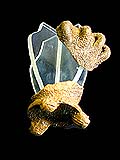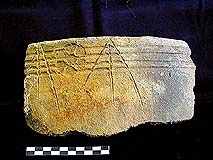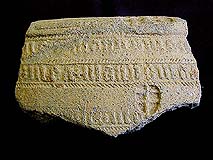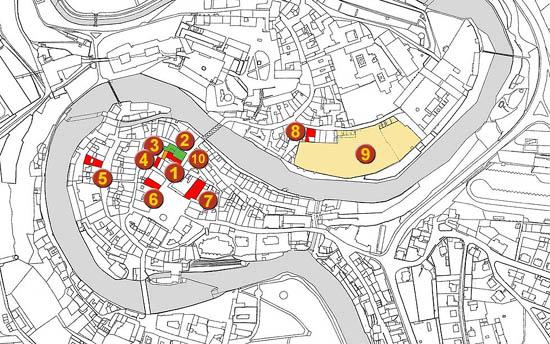The archaeological researches in the town of Český Krumlov
There has been a very short tradition in archaeological researches in the area of the today town of Český Krumlov so far. The Šumava Museum in the village of Horní Planá used to be the centre of the pre-war research in the region of Český Krumlov , particularly connected with the name of Karel Brdlík - the teacher and amateur archaeologist. The archaeological research in the District National History and Geography Museum in the town of Český Krumlov was established in 1993.

|

|

|
||
|
Pic. 1 |
Pic. 2 |
Pic. 3 |
Pic. 1 - The fragment of the Loštický cup imitation on the stipes in the shape of lion heads. The popular pottery was made in Loštive na Moravě in the second half of the 15th century - particularly little cups which surface is covered with little blisters caused by ferric ingredients, Český Krumlov, nám. Svornosti No. 11.
Pic. 2 - The storage vessels fragments - large vessels to store and transport food and other goods. The area of the today Hotel Růže (the Hotel Rose), the 15th century. The Money Collection Fund of the District National History and Geography Museum in the town of Český Krumlov.
Pic. 3 - The storage vessels fragments - large vessels to store and transport food and other goods. The area of the today Hotel Růže (the Hotel Rose), the 15th century. The Money Collection Fund of the District National History and Geography Museum in the town of Český Krumlov.
In 1933 the Neanderthal man settlement was uncovered in Dobrkovice (Dobrkovice Cave). This part was not associated with Český Krumlov at that time. The professional archaeologists has been doing the real research work in the town of Český Krumlov since the beginning of 1990´s. Before that only the stone hammer dating from the turn of the 5th and 4th century BC excavated in the Český Krumlov Castle area (The Český Krumlov Castle Primeval Settlement) and several medieval pottery fragments had been found during the structural work in the town centre in 1970´s and 1980´s. For example, during the restoration work of the Hotel Růže (the Hotel Rose) No. 154 in Horní Street, citizen houses in the south side of Svornosti Square , etc. However, many archaeological remains had been damaged irretrievably. Archaeologists have always been present on structural work since 1990´s. It is almost their daily routine.

The map of the historical centre of the
town of Český Krumlov. The most important area researches during
the years 1990-2000 are marked in the map, worked up by Michal
Ernée, 2000.
- House No. 27 in Radniční Street
- The archaeological research of the house No. 29 in Radniční Street
- The archaeological research of the yard behind the houses No 25, 27 in Radniční Street
- House No. 20 in Panská Street
- House No. 74 in Široká Street
- House No. 15 in Svornosti Square
- House No. 2 in Svornosti Square
- House No. 23 in Latrán
- The Archaeological Research of Area called Low Manorial Garden
- The archaeological research of the house No. 25 in Radniční Street
In the year 1991/92 the remains of the Slavic cottage dating from the 8th century , some earthenware and a stone wedge dating from the 5th century BC were uncovered in the Low Manorial Garden (The Primeval and The Early Middle Ages Settlement in the area of the town of Český Krumlov). Much excavation work has been done in the town centre since then, particularly in the citizen houses interiors. The extensive area research was done in the Český Krumlov State Castle during the year 1994/95 (The archaeological research of the Český Krumlov Medieval Castle). A large number of discoveries dating back to the Middle Ages (the 13th - 15th century) and dating from the Modern Period have been done in the town (The archaeological research of the town of Český Krumlov).
(me)
Further information :
Archaeological
Research in the Český Krumlov Region
Dobrkovická
Cave

